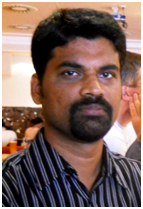










|
Title of Talk An organic “nano” optical waveguide is in Action
Abstract Nanoscale optical wave guides are one of the important components of miniaturized nano-photonics devices.1 In particular, one dimensional (1D) organic solids are promising candidates to manipulate and guide optical waves in the nano/submicro/micro domains, due to the dielectric difference between the organic solid and the surrounding medium. Based on the type of light a 1D solid propagates, organic optical wave guides can be classified into active- and passive-waveguides. Active wave guides propagate PL light through exciton-polariton mechanism. On the other hand, passive organic wave guides directly propagate input light to the output end. Our group has recently discovered for the first time the passive organic wave guiding tendency of organic submicrotubes.4-6 The weak Raman interaction of the propagating light with the tube molecular building blocks can also be used to pin-point nano/micro scale defect sites inherited during the self assembly process.5 We have also demonstrated the potential utility of the wave guiding submicrotubes to remotely excite a porphyrine nano-sheet positioned 20 microns away from the source laser.6 Further more we have developed laser cutting techniques to cut the longitudinal dimension of 1D organic solids, thereby precisely controlling the light propagation distance and optical out-puts.
Figure 1. A passive organic waveguide with two out-puts in action.
References: 1. Hunsperger, R. G. Integrated Optics: Theory and Technology, 5th ed.; Springer: Berlin, 2002. 2. Chandrasekhar, N.; Chandrasekar. R. Chem. Commun., 2010, 46, 2915. 3. Basak, S.; Chandrasekar. R. Adv. Funct. Mater., 2011, 21, 667. 4. Chandrasekhar, N.; Chandrasekar. R. Angew. Chem. Int. Ed. 2012, 51, 3556. 5. Hui. P; Chandrasekar. R. Adv. Mater. 2013, 25, 2963. 6. Chandrasekhar, N.; Mohoiddon, M. A.; Chandrasekar. R. Adv. Opt. Mater. 2013, 1. 305. |
|
Rajadurai Chandrasekar, Associate Professor
Functional Molecular Nano/Micro Solids Laboratory, School of Chemistry, University of Hyderabad, Hyderabad – 500 046, INDIA e-mail: rcsc@uohyd.ernet.in
Since 2008, his group has been working on the creation and understandings of the functional molecular nano/micro scale structures possessing unique magnetic and photonic properties. He initiated an original research field in area of organic photonics known as “passive organic wave guides”. He has been awarded the TU-Darmstadt Graduate College Fellowship in 2001, Max Planck Partner Group Grant Award in 2010 and YIM Boston Young Scientist Award in 2013.
Selected Publications 1. Basak, S.; Chandrasekar. R. Adv. Funct. Mater., 2011, 21, 667. 2. Chandrasekhar, N.; Chandrasekar. R. Angew. Chem. Int. Ed. 2012, 51, 3556. 3. Hui. P; Chandrasekar. R. Adv. Mater. 2013, 25, 2963. 4. Chandrasekhar, N.; Mohoiddon, M. A.; Chandrasekar. R. Adv. Opt. Mater. 2013, 1. 305. 5. Basak, S.; Hui, P.; Chandrasekar, R. Chem. Mater. 2013, 25, 3408. |

